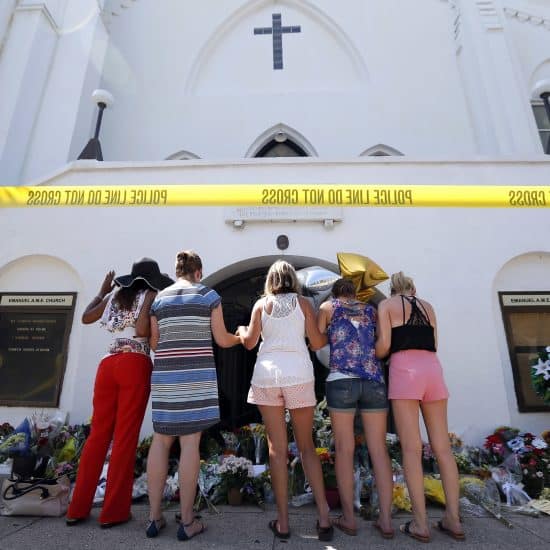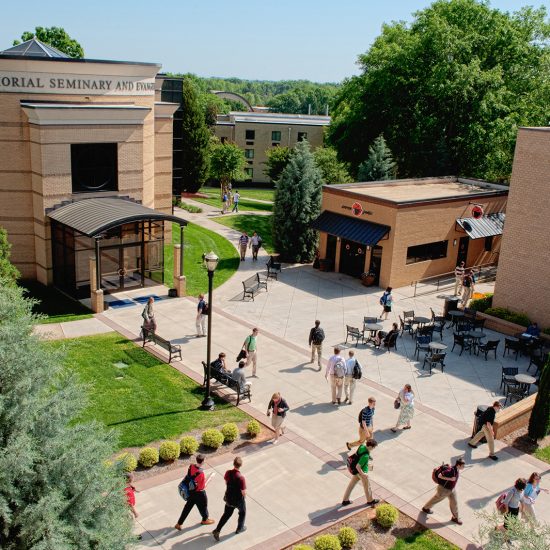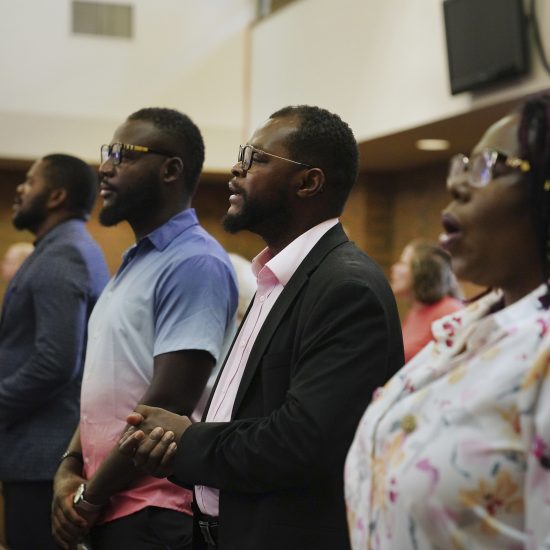
What happened next may come as a surprise to residents of a city burnished by a legacy of free state abolitionist sentiment and knowledge of the mass slaughter of men and boys by William Quantrill’s pro-slavery raiders. The three Black men, with tacit endorsement of local law enforcement, were at the mercy of vigilantes. The throng placed ropes around the neck of each man. They were hung until dead from the old stone, wood and steel river crossing.

In 1882, three Black men were hanged by vigiilantes from a Lawrence bridge since replaced by this modern crossing over the Kansas River. (Tim Carpenter/Kansas Reflector)
“Early one morning in June of 1882, a masked mob of 100 men broke into the city jail and pulled out three African-Americans who had been jailed just a day or two previously,” said Randy Krehbiel, a member of Plymouth Congregational Church in Lawrence. “Took them to the bridge, which was a short distance away, a bridge over the Kansas River, and hung them off steel girders.”
Two of the three had been arrested for murder of a White man, but no evidence tied Vinegar to that crime. Cindy Schott and Kathy Schott Gates wrote about the lynching in their book, Boys, Let Me Down Easy. The title came from reports of King’s final words. His killers apparently obliged by lowering him gingerly to allow him to slowly strangle rather than swiftly cause death by snapping his neck.
On Friday (Feb. 12), Kansas Interfaith Action conducted a virtual vigil to draw back the curtain on lynchings and other forms of racial terrorism in Johnson, Shawnee, Saline, Crawford, Sedgwick, and Douglas counties. It was an effort to amplify underreported history of Kansas, but also register opposition to the death penalty, point to flaws in the criminal justice system, and note prevalence of racism in America.
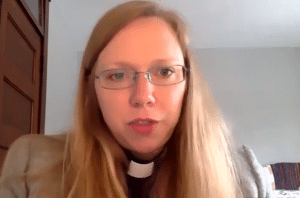
The Rev. Rachael Pryor, board chairwoman of Kansas Interfaith Action. (Screenshot/Kansas Reflector)
“This isn’t just about looking back and apologizing for something that happened a long time ago,” said the Rev. Rachael Pryor, board chairwoman of Kansas Interfaith Action. “The same attitudes that allowed for, and even celebrated lynching a century ago, are still present in our communities and systems, distorting rights, relationships, and racial justice.”
She said communities should own up to the past in which predominantly White faith organizations were complicit in racialized terror by dedicating themselves to changing behavior in people going forward.
“We cannot afford to lose another generation of Black and brown young people to a prison system that seeks to punish, warehouse and dehumanize them,” said the Rev. Robert Johnson, pastor at Saint Mark United Methodist Church in Wichita. “Black Kansans know how directly Kansas’s history of racial discrimination leads to constricted opportunities and even criminalization of Black and brown people today.”
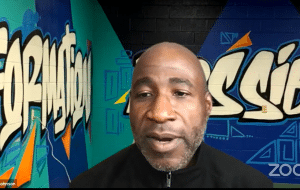
The Rev. Robert Johnson, pastor at Saint Mark United Methodist Church in Topeka.(Screenshot/Kansas Reflector)
Johnson said he was concerned by the frequently short-lived reaction of people to racial tragedies such as the death of George Floyd, the 46-year-old Black man who died in custody of Minneapolis, Minnesota, police on May 25, 2020. A White officer knelt on Floyd’s neck for about nine minutes while the suspect was handcuffed and lying face down. Floyd’s death sparked international protests and outrage.
“There will be a period of dramatic events. People will respond in shock and awe. After a period of time, things die down and they go back to normal,” Johnson said. “How do we not let the energy die down? How do we not allow people to go back to business as usual? We think that one of the things that needs to happen is the people of our country need to be given a broader understanding of both the history of our country but … the racial history that happened here in Kansas.”
Evidence of lynchings in Kansas extend to Saline County, where a Black man was arrested in 1893 for allegedly injuring a White boy with a razor. Rumors of a possible lynching convinced the sheriff to arrange transfer of suspect Dana Adams to Leavenworth by railroad. Adams was placed in a Union Pacific passenger car, but vigilantes unhitched the car as the train pulled away. The crowd gained access to Adams and hung him a telegraph pole at the station. No arrests were made in the slaying.
In 1889, well-known burglar Nat Oliphant was arrested in the death of A.T. Rogers of Topeka. A crowd gathered at the jail managed to punch a hole in the building’s wall and gain entrance to the cell block. They threw a rope around Oliphant to drag him down the stairs and out of the jail. He was hanged from a pole near First National Bank building downtown. His body was reportedly cut down and put on display by a local undertaker. After burial, the corpse was stolen.
The southeast Kansas county of Crawford was witness in 1885 to the lynching of John Lawrence, 17. He was suspected of assaulting a girl. About 20 men broke down the door to Girard’s jail and proceeded to hang the Black man from rafters of an unfinished home. News accounts say the girl’s father emptied a handgun into Lawrence before the crowd dispersed.
Pryor said these history lessons about racial terror in Kansas could serve as motivation to address criminal justice, poverty, and other issues linked to racist law, policy and ideology. She said records of lynchings were incomplete in Kansas and the names of some victims have been lost. But the goal of hordes who sidestepped the legal system to impose their version of justice did little to obscure their intent to kill people and send a message to others in their communities, she said.
“To clearly say, ‘You had also better watch out, because what happened to this person could also happen to you,’” she said. “A lot us know a little bit about the history of the free state movement for Kansas. Maybe we even think of Kansas as a place that really stood up in opposition to slavery. That is not the whole story.”
This article was originally published by the Kansas Reflector and authored by Tim Carter. Kansas Reflector is part of States Newsroom, a network of news outlets supported by grants and a coalition of donors as a 501c(3) public charity. Kansas Reflector maintains editorial independence. Contact Editor Sherman Smith for questions: info@kansasreflector.com. Follow Kansas Reflector on Facebook and Twitter.

